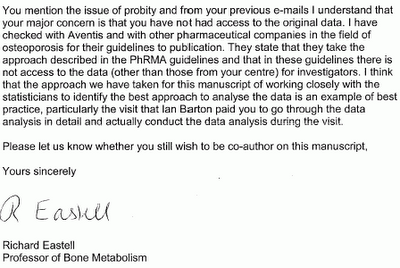There were three elements to the problem:
- A pharmaceutical benefactor (Proctor & Gamble) repeatedly refused to provide raw data including randomization codes to academic "collaborators". Data was required by the academics to verify scientific reports, statistical analyses, meeting abstracts (1,2), and draft publications "ghost written" in their names.
- Data was provided to authors 3 years later, in early 2006, following press exposure. "Fair" analysis of the data would not have yielded findings desired by the sponsor.
- There were multifaceted and intriguing attempts to prevent the problem from being raised or discussed.
The writer is Professor Richard Eastell, collaborator in this research, and then Research Dean of Sheffield Medical School. It was written after numerous attempts to gain access to data from the company, and after some information had emerged to suggest that the analysis performed by P&G was implausible. A publication based on overlapping data had already appeared in press (Eastell et al., 2003 J. Bone. Miner. Res. 18:1051-6) - the raw data underlying this overlapping paper had also not been disclosed to Sheffield authors (BBC broadcast).
This letter from Professor Eastell was written in response to two letters from myself here and here. Eastell's "response":
- attempts to rationalize why it was appropriate for authors to be refused access to critical raw data
- suggests that the first author (Blumsohn) would be removed even as a coauthor unless prepared to sign a journal declaration in the absence of data


Click here for PDF version of letter or on images above to enlarge.
Abstracts underlying intended publications
- A. Blumsohn, IP Barton, A Chines, R Eastell Relative Contributions Of The Early Changes In Bone Resorption And Later Changes In Hip Bone Mineral Density To The Reduction In Vertebral Fracture Risk With Risedronate. [J Bone Miner Res 2003;18(S2):S157 Abst#SA337
- A. Blumsohn, IP Barton, A Chines, R Eastell. Relationship Of Early Changes In Bone Turnover To The Reduction In Vertebral Fracture Risk With Risedronate - The HIP Study. [J Bone Miner Res 2003;18(S2):S89 Abst#F338
Earlier|Later|Main Page
9 comments:
Dreadful, condescending balderdash. This contravenes ICJME guidelines and every dictum of authorship. From what Eastell says, all publications in the field of osteoporosis should immediately be examined. Thank god I'm retired.
[technical note: You have one acrobat correspondence missing (the one from Eastell is duplicated)].
I'm outraged and I am paying attention. What was P&G thinking!
The guidelines from PhRMA say that there is not access to the data (other than those from your centre)for investigators? Is there a reference for you to look this up?
Of course PhRMA "guidelines" don't say that (for what "guidelines" from this discredited lobby group are worth anyway).
This is a complete red herring - eveyone accepts that an individual scientist in an individual center who recruits 5 patients of 5000 in a large multicentre RCT might not have access to the entire study database (but even that should be debated). It has nothing whatever to do with the rights and obligations of a scientific author or principal investigator!
See next post.
I have always held Richard Eastell in the highest regard, but this looks bad to me. I'm very sorry.
A friend.
Mamma Mia!
How long did it take Eastell to master the art of writing such putrid nonsense? And why have you stopped blogging?
here -: http://www.thyroiduk.org.uk/tuk/search/search.php?zoom_query=weetman
:( :(
Have you seen this old story?
http://www.dbdouble.freeuk.com/Dangeroustalk.htm
Post a Comment